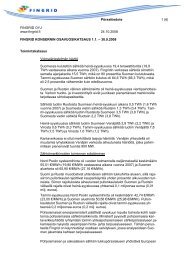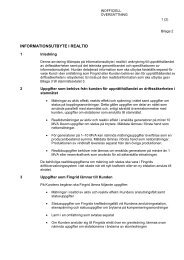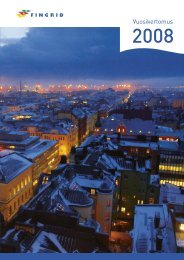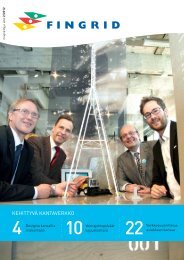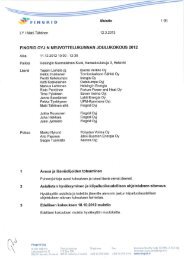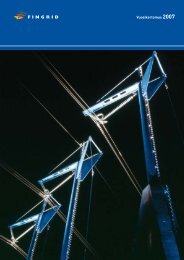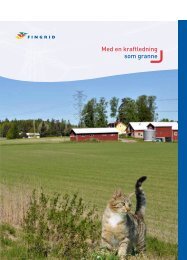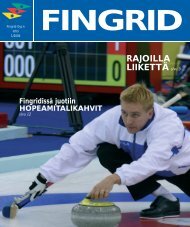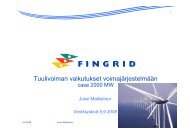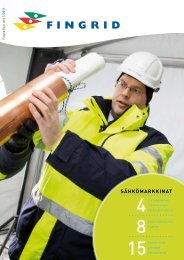Living adjacent to a transmission line - Fingrid
Living adjacent to a transmission line - Fingrid
Living adjacent to a transmission line - Fingrid
Create successful ePaper yourself
Turn your PDF publications into a flip-book with our unique Google optimized e-Paper software.
Many ways <strong>to</strong> utilisethe <strong>transmission</strong> <strong>line</strong> areaHUNTINGGood visibility renders <strong>transmission</strong> <strong>line</strong> areas suitedfor hunting. For safety reasons, the shootingplaces must be located so that the <strong>line</strong> structuresare not in the <strong>line</strong> of fire. The erection of hunting<strong>to</strong>wers should be agreed upon in advance with<strong>Fingrid</strong>. Game fields can be established on oldfields located in rights-of-ways. A permit for clearingnew fields should be requested from <strong>Fingrid</strong>.ESTABLISHING A ROAD OR OUTDOOR ROUTEYou can jog and ski in a <strong>transmission</strong> <strong>line</strong> area. Apermit from the landowner and a statement from<strong>Fingrid</strong> are required for the building of a road,outdoor recreation route, jogging track or skiingtrack in a <strong>transmission</strong> <strong>line</strong> area.USE OF SNOWMOBILESWith the landowner’s and <strong>Fingrid</strong>’s permit, a<strong>transmission</strong> <strong>line</strong> area can be used for snowmobileriding. Snowmobile riding is, however, strictly forbiddenin <strong>to</strong>wer areas. A snowmobile route mustbe placed so far from the <strong>to</strong>wers that there is norisk of collision with the <strong>to</strong>wer legs or guys.In addition <strong>to</strong> cultivation and grazing, rights-ofwayscan be utilised in many ways.BUILDINGS AND STRUCTURES<strong>line</strong>. It is advisable <strong>to</strong> inform <strong>Fingrid</strong>, which decideson the placing of power <strong>line</strong> bird markers, of other similar components. The sound caused bynear the surface of conduc<strong>to</strong>rs, insula<strong>to</strong>rs and12It is forbidden <strong>to</strong> construct a building in a13RECREATIONAL USES<strong>transmission</strong> <strong>line</strong> area. If you want <strong>to</strong> build otherlocations where birds collide with a <strong>line</strong>.corona is loudest in moist weather or in the winterA <strong>transmission</strong> <strong>line</strong> area is suited for many types structures such as shelters, roads, parking areas,when hoar frost accumulates on the conduc<strong>to</strong>rs. ItThere has been extensive research on the potentialhealth impacts of the electric and magneticof recreational uses. You can hike and pick berries overhead <strong>line</strong>s, underground cables, water pipes,is practically almost impossible <strong>to</strong> prevent coronaand mushrooms in a <strong>transmission</strong> <strong>line</strong> area. Transmission<strong>line</strong>s also constitute habitats favoured by a permit must be acquired from <strong>Fingrid</strong> for thesewers, lighting posts, flag poles, fish basins etc.,discharge completely, but since the sound is alwaysan indication of energy losses, the goal is <strong>to</strong>fields created around <strong>transmission</strong> <strong>line</strong>s. Based onresearch findings, these fields do not cause a riskbutterflies and many plant species.location and building of these.reduce this phenomenon. Corona occurs mainly at<strong>to</strong> people or animals. Publications on this <strong>to</strong>pic inthe 400 kV voltage level.Finnish can be downloaded from <strong>Fingrid</strong>’s website.Long lighting <strong>line</strong>s and other <strong>line</strong>s laid over theground under a <strong>transmission</strong> <strong>line</strong> may also causea hazard. A permit is also needed if you wish <strong>to</strong>make changes <strong>to</strong> a structure built earlier in the<strong>transmission</strong> <strong>line</strong> area.SOIL EXTRACTION AND DISPOSAL, DITCHINGA permit from <strong>Fingrid</strong> is required for the extractionof gravel, sand, clay, earth and peat in theright-of-way. The same applies <strong>to</strong> ditching andsoil heaps being dumped in a <strong>transmission</strong> <strong>line</strong>area.It is prohibited <strong>to</strong> dig ditches in a <strong>to</strong>wer area.The sides of a ditch must never be closer thanthree metres from the <strong>to</strong>wer and guy structures.If the depth of a ditch <strong>to</strong> be dug is more thanhalf a metre, the underground grounding electrodesmust be taken in<strong>to</strong> account. <strong>Fingrid</strong> mustbe informed immediately of broken groundingelectrodes.Good <strong>to</strong> knowScientific research has not found that <strong>transmission</strong><strong>line</strong>s would have adverse effects on the healthor fertility of pasturing animals. It has not beenestablished that the licking of wooden <strong>to</strong>werswhich have been treated with creosote would havenegative effects on animals. A statement on thisissue has been submitted, among others, by theDepartment of Food and Environmental Hygieneof the University of Veterinary Medicine in Finlandon 25 Oc<strong>to</strong>ber 1994.Power <strong>line</strong> bird markers can be used on theconduc<strong>to</strong>rs near the routes of migra<strong>to</strong>ry birds orin locations where birds nest <strong>to</strong> warn birds of theAccording <strong>to</strong> the Finnish Meteorological Institute,<strong>transmission</strong> <strong>line</strong>s do not increase lightningnor direct the movements of thunder clouds, butthe <strong>line</strong>s actually increase lightning safety. Sincethe <strong>transmission</strong> <strong>line</strong> <strong>to</strong>wers are usually higherthan their immediate environment and sincethey are also grounded, they ”attract” strokes oflightning which would strike in any case in the<strong>adjacent</strong> area.The <strong>line</strong> is constructed so that a stroke of lightningis guided through the overhead ground wirein<strong>to</strong> the ground in a harmless manner. In otherwords, it is not advisable <strong>to</strong> stay in the immediatevicinity of a <strong>transmission</strong> <strong>line</strong> during thunders<strong>to</strong>rm.Transmission <strong>line</strong>s cannot influence the number ofstrokes of lightning, either. Their number dependsentirely on the properties of the thunder cloud,not on the underlying <strong>to</strong>wers.The buzzing sound heard near a <strong>transmission</strong><strong>line</strong> is caused by corona discharge occurring onthe surface of the conduc<strong>to</strong>rs or insula<strong>to</strong>rs. Thecorona phenomenon is harmless <strong>to</strong> people. Thephenomenon is caused by the ionisation of airHigh-voltage <strong>line</strong>s may also cause sounds createdas a result of wind which shakes the various partsof the <strong>line</strong> such as steel <strong>to</strong>wers, conduc<strong>to</strong>rs, crossarmsor insula<strong>to</strong>rs. These sounds occur irrespectiveof whether the <strong>line</strong> is live or not.



